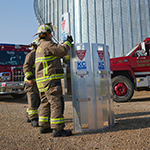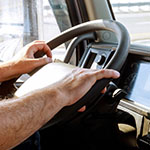Avoiding slips and falls
Plan ahead to minimize weather-related losses.
Falls take around 12,000 lives and cause more than 30,000 disabling injuries annually, reports the Occupational Safety and Health Administration (OSHA). Those numbers don’t even approach the number of lesser injuries caused by slips, trips and falls every year.
In many parts of the country, rain, snow and ice add to the risk. According to the National Floor Safety Institute, 80 percent of slips happen on wet floors. So, consider stepping up your efforts to keep walking surfaces clear and dry — and employees and customers safe.
How to prevent weather-related falls
- Keep parking lots, walkways and entrances clear of mud, snow and ice. Be proactive and monitor weather to anticipate slippery conditions. Keep shovels and gloves readily available.
- Assign workers to remove snow or other hazards from parking lots and walkways before employees and customers arrive for the day. Use salt, sand or another slip-resistant material to help keep areas clear.
- Install slip-resistant flooring material, such as mats with textured or serrated surfaces, around entry ways and other areas prone to wet conditions.
- Require workers to wear footwear appropriate for conditions.
- Use “Caution — Wet Floor” signs if you’re caught off-guard or temporarily unable to keep ahead of floor clearing tasks.
- Provide good lighting and clear path markings in parking lots, stairs and walkways.
- Clearly identify steps, ramps and other elevation changes.
Build an effective fall prevention program
- Set written standards for conditions of parking lots and walkways.
- Establish standards for the type of slip-resistant footwear and other safety gear employees should wear and use.
- Define employee roles in preventing slips and falls, and share that information with your staff.
- Train employees — assigned to clearing lots and walkways — how to avoid back injuries and overexertion.
- Follow-up to assure fall prevention program standards are being met.
- Acknowledge success and make improvements where needed.
Talk with your drivers
Drivers getting in and out of vehicles are especially susceptible to falls. The risk rises substantially in the presence of mud, ice or snow. It’s a risk faced by all drivers, but it’s particularly high for operators of large trucks. Instruct your truck drivers to always use the three-point stance while getting in and out of their cabs. This means always keeping both hands on the vehicle for support as you raise or lower one leg at a time.
Conduct a walk-through
Although winter weather presents a heightened risk for slips and falls due to wet floor surfaces, it’s by no means the only factor. Spills can occur anywhere. Instruct all workers to clean up all spills immediately. We also suggest your safety committee conduct a walk-through of your entire operation to identify hazards while employees are at work. Information gathered should be used to minimize each identified hazard.

 >
>

 >
>
 >
>